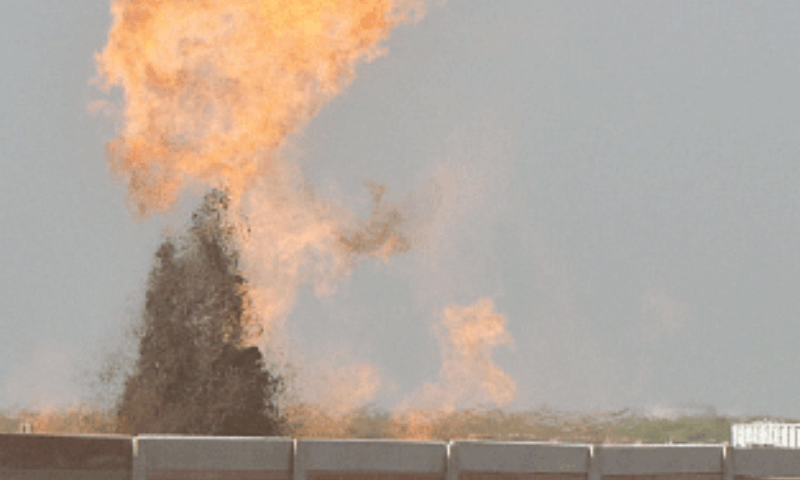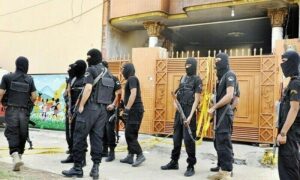KARACHI: The Pakistan Petroleum Limited (PPL) is set to initiate the process to contain and extinguish a mysterious huge fire that erupted last month during drilling for a borehole in Korangi Creek near an oil refinery after a report of the chemical analysis of groundwater and soil samples shows the presence of gases like benzene and toluene and minerals like iron and magnesium in much higher concentration under the ground.
Korangi deputy commissioner Masood Bhutto confirmed that experts concerned had submitted their report of the Korangi Creek fire incident.
He told Dawn the report showed presence of ‘heavy metals’ and the presence of gases like benzene in large quantities.
Regarding future course of action after the experts’ report, the DC said the PPL would initiate the process of containing the fire with help of experts.
Korangi DC says initial report shows presence of various gases, minerals in soil, groundwater samples
Subsequently, the gas exploration would be carried out to see the extent of the presence of gas up to five-kilometre areas.
He recalled that initially, it was presumed by the PPL experts that there were “shallow gases” which might exhaust themselves. Therefore, the administration and firefighters had halted the operation of extinguishing the fire on the experts’ advice as it might be harmful.
“But now as the gases have not consumed themselves and the intensity of the flames has remained the same for the last eight days, the PPL experts have deemed it fit to start an exploration activity to find gases inside the reservoir,” he said.
The DC recalled that during construction of a high-rise project, drilling for a borehole was done up to 1,200 feet that might have broken the “shale” and gases emitted, which triggered the fire that did not stop till now.
Rescue-1122 spokesperson Hassaan Khan also confirmed that findings of the experts regarding the chemical analysis of boiling water had been shared with them.
Sharing the gist of the report, Mr Khan said that it has been noted that excessive amounts of benzene, toluene and tetrachloroethane has been found in the boiling water.
Regarding the quantity of the chemicals found in the water, he said as per chemical analysis, tetrachloroethane was detected at 33 micrograms per litre instead of the permissible five micrograms per litre.
The preliminary chemical report also shows that benzene level was found to be 19 micrograms per litre instead of the allowed five micrograms. Similarly, toluene detected at 15 micrograms per litre, exceeding the permissible limits of five micrograms.
In the report, the level of iron was 181.6mg/L against the reporting limit of 0.005; arsenic was 0.014mg/L; manganese 2.721mg/L; and lead was 0.032 mg/L against RL of 0.005.
The Rescue 1122 spokesperson said the chemical experts’ report shows that there was concentration of chemicals but the exact quantity of the chemicals at the site of the burning inside underground/reservoir was still not known.
In a recent filing to the Pakistan Stock Exchange, TPL Properties had stated that during a preliminary site investigation near Korangi Creek, its team encountered a pocket of underground gas while drilling a test well for water exploration.
“Based on initial technical evaluations as well as independent views expressed by industry experts indicate that the gas may be shallow biogenic methane, a naturally occurring gas resulting from organic material decomposition. Since this area is not part of a known natural gas reservoir, and based on similar occurrences elsewhere, this gas pocket is expected to dissipate naturally over time provided the flame is allowed to burn.
“The recent test was part of a series of extensive studies conducted over the past two years to reinforce our commitment to responsible and well-planned development. These assessments — carried out in collaboration with leading national and international consultancy firms — include geotechnical studies, soil composition and contamination tests, electrical resistivity surveys, a comprehensive environmental and social impact assessment and other baseline studies.
“All field investigations, including the recent hydrological study, were conducted with the necessary approvals from relevant authorities and in full compliance with regulatory standards,” it added.
Published in Dawn, April 7th, 2025











